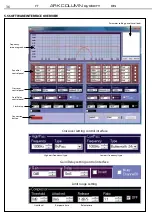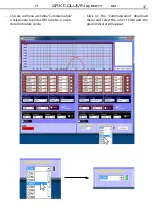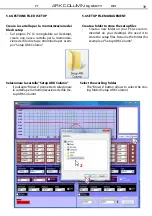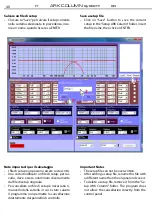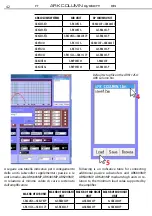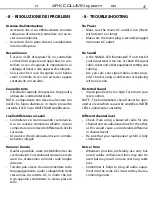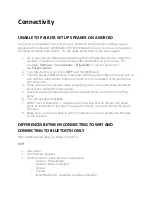
50
ARK COLUMN system
EN
IT
speaker with a power well below its AES appli-
cable power rating if it is required to reproduce
a distorted signal at a low frequency that causes
a cone excursion beyond the physically con-
sented limit.
Input sensitivity and clipping. How to avoid
clipping
Every amplified speaker is characterized by a
value of input sensitivity. The sensitivity is de-
fined ad the value of the amplifier’s input signal
that will result in maximum power output. An
increase in input signal over that threshold will
result, not in increased power, but in a distortion
phenomenon called “clipping” (output stage
saturation).
In this condition, the speaker will operate im-
properly. The diaphragm will exceed it’s excur-
sion limits, and the voice coil will overheat be-
yond it’s thermal limits, resulting in overheating
and premature failure. The active processors
will help in avoiding clipping, by reducing the
amplifier gain and thus the input sensitivity, but
this type of protections may be overridden in
very extreme conditions. What the active pro-
cessor cannot modify is a signal that is distorted
before getting to the active speaker’s input.
The effect of this type of signal are the same as
described above.
How to avoid clipping
The simplest way to avoid clipping is to check each
level in the signal’s chain. Start from each input
channel of the mixer and adjust the gain control
and the equalizer’s controls so that the PFL me-
ter will never (or only occasionally) indicate more
than 0dB. In simpler mixers, check that the “clip”
or “peak” indicator is always off, or blinks only oc-
casionally. If these levels are exceeded the active
speaker’s or the power amplifier’s input sensitivity,
as displayed on the master output VU-meter.
tore. La potenza di breve termine IEC268-5 è la
potenza che il diffusore può sopportare per un
brevissimo intervallo di tempo. Corrisponde a
4 volte la potenza AES e viene calcolata in base
alla massima tensione di picco che l’amplificato-
re consigliato può fornire al diffusore. Le capa-
cità in termine di SPL nei transistori del segnale
musicale, sono effettivamente corrispondenti a
tale valore; quindi il dato di SPL max fornito nella
tabella delle specifiche tecniche viene calcolato
in base a tale valore di potenza. Attenzione: il
dato di potenza che effettivamente corrisponde
alle capacità termiche del diffusore di dissipare
potenza elettrica per lungo periodo è quella
AES. Tutti gli altri dati si riferiscono a “capacità
transitorie” del diffusore di accettare potenze
correlate con la natura del segnale audio che
sono destinate a riprodurre.
Sensibilità e clipping. Come evitare il clipping
Ogni sistema amplificatore-altoparlante è carat-
terizzato da una sensibilità di ingresso. La sensi-
bilità è definita come il valore del segnale di in-
gresso all’amplificatore che produce la massima
potenza in uscita. Aumentando il segnale oltre
tale valore, infatti, non si ottiene una maggiore
potenza di uscita, ma soltanto un fenomeno di
distorsione detto “clipping” (saturazione).
In questa situazione l’altoparlante lavora in
modo improprio. Si hanno delle sovraescur-
sioni e una dissipazione anomala nella bobina
mobile, che si surriscalda e può rompersi. I pro-
cessori attivi possono evitare solo parzialmente
il clipping, abbassando il guadagno dell’amplifi-
catore. È possibile, in casi estremi, oltrepassare
anche questo tipo di protezione. Ciò che il pro-
cesso non può modificare è un’onda che arrivi
già distorta in ingresso all’amplificatore.
Gli effetti di un segnale di questo tipo sono gli
stessi descritti sopra.
Summary of Contents for ARK COLUMN Series
Page 1: ...MANUALE UTENTE USER MANUAL ACTIVE PASSIVE LOUDSPEAKERS IT EN ARK COLUMN system...
Page 52: ......
Page 53: ......
Page 54: ......
Page 55: ......

